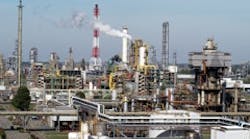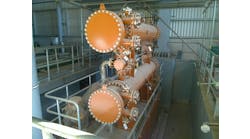BASF’s Antwerp complex is the largest chemical plant in Belgium and the company’s second largest site worldwide. Located near the Scheldt River, it comprises 53 production facilities and has some 3,600 employees. The plant produces mineral fertilizers, plastics, chemicals and derivatives that go to customers in Europe and elsewhere.
The site is highly integrated — raw materials, products and byproducts from our processes are utilized elsewhere on-site. This puts extraordinary responsibilities on the production and maintenance departments because downtime in one unit can affect productivity down the line.
In the past, we relied principally on time-based preventive maintenance to protect equipment from failure. However, this was inefficient and didn’t prevent production losses — making it a very costly strategy, exceeded only by letting equipment run to failure and then reacting in emergency mode.
BASF’s Antwerp complex, located near the Scheldt River, is the largest chemical plant in Belgium.
Several years ago, we decided to implement predictive maintenance based on monitoring the condition of key assets. We periodically take vibration measurements on some 3,000 machines throughout the facility. These data are evaluated by experts to predict when a machine will need to receive service so it can maintain the required performance. Machines that are smoothly operating aren’t taken out of service according to a schedule but are allowed to run as long as there’s no threat to productivity. However, if the vibration data indicate a potential problem, the analysts look more closely to determine its nature and severity so service can be scheduled at the most convenient time. Occasionally we identify a machine that must be immediately shut down to prevent an imminent breakdown resulting in downtime for one or more units in the plant.
Moving from time-based maintenance to this approach has resulted in significant cost savings because fewer unexpected equipment breakdowns occur.
Crucial Analyzers
The program was initiated using CSI 2115 Machinery Health Analyzers from Emerson Process Management. We now have four of these measurement instruments, which our technicians take into the plant to collect data at various points on electric motors, pumps, gear boxes, fans, centrifugal compressors and other rotating equipment. We periodically check each machine according to a priority list that ensures that critical machines get the most frequent examination.
Measurements from each machine are recorded and later uploaded to a computer for spectral analysis using Emerson’s AMS Suite: Machinery Health Manager. This predictive maintenance software can effectively diagnose equipment problems, detect the type of failure and determine its exact location. The results not only paint a valid picture of the condition of these mechanical assets at the time the readings were taken but form the basis for predictions of future health issues that could affect operations.
Occasionally we detect critical problems that couldn’t have been seen before — such as defective bearing cages and faults in slow speed machinery. For example, with the aid of our diagnostic technologies we determined that one of the fans used in drying chalk had a defective bearing cage; it was serious enough for the fan to be taken out of service despite the negative impact on production. The fault was confirmed when the fan was visually examined. A failure during operation could have caused secondary damage, such as a bent shaft or failed bearing, and led to at least a two-day production outage. That would have resulted in a maximum loss of several hundred tons of chalk worth approximately $14,500, plus the cost of emergency repairs. Because the problem was discovered before a failure occurred, we saved one full day of work — because only the defective component had to be replaced.
With the available tools our maintenance team has increased its ability to troubleshoot machinery problems, analyze multi-channel data and do operating deflection shape (ODS) analysis. We’ve been able to use our own expertise along with Emerson technologies to keep watch over a broad scope of assets throughout this huge facility to prevent costly problems from occurring.
Just the Start
We’re continuing to enhance our predictive maintenance capabilities.
For instance, we’ve begun using Emerson’s CSI 2130 Machinery Health Analyzer, an advanced route-based collector/analyzer that records vibration levels and analyzes the data in the field for faster detection of problems. It warns of a potential problem even before the sensors are lifted from a machine. Then, if additional information is required for a better diagnosis, the technician can take more measurements immediately, before specific corrective actions are initiated.
When combined with information from other sources, such as lubricant analysis and infrared imaging, a true picture of the operating condition of monitored assets and their potential for failure emerges — providing the basis for even-more-effective proactive maintenance in the future.
Johan De Wever is a rotating equipment specialist for
BASF, Antwerp, Belgium. E-mail him at [email protected].


